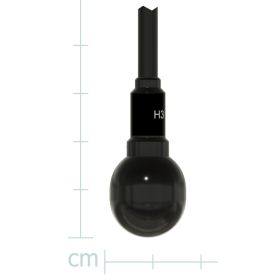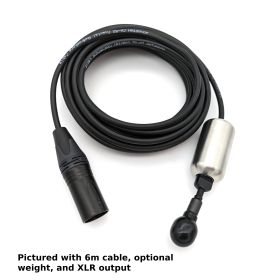The H3 hydrophone was designed as a leak finding tool. It offers exceptional sensitivity in a very small size that can easily be inserted into plumbing systems. Additionally, its mechanically-balanced dual-element design minimizes acceleration noise. This helps lower handling noise and vibration-induced noise. The H3 is also used as a waterproof microphone in industrial applications where dust and coolants would make standard microphones unreliable.
The H3 hydrophone can be optionally assembled with our WT150g sliding stainless steel weight assembly for sinking the hydrophone. There are several advantages to placing the weight on the cable, rather than building it into the hydrophone. When the hydrophone is dropped, the cable flexes and deflects that impact away from the hydrophone. It also dampens vibrations in the cable that would be induced into the hydrophone signal as acceleration noise. The weight can be moved if needed to allow insertion into a pipe. These attributes are especially useful to the leak detection specialist.
Output Options:
- H3: 1/4" TS output for use with PA1 amplifier, any high-impedance hydrophone or instrument amp or your custom design.
- H3b: Same as H3, but with BNC output, for use with the PA6 amplifier, typical test equipment, or your custom design.
- H3m: Buffered output (3.5mm TRS) for use with any consumer-grade microphone preamp that offers plug-in power.
- H3x: Same as H3m, but with XLR output, for use with professional-grade microphone preamps, phantom power required.
Features:
- Low cost
- Small size (16.5mm diameter)
- High sensitivity
- Robust, low-mass design provides high mechanical shock resistance
- Balanced element design minimizes acceleration noise
- Available in four different output configurations to interface with almost any microphone amp
- Compact (4.5mm OD) Low-noise cable with tough urethane jacket
- High dynamic range
- Low self noise
- One-year limited warranty
User Manuals: H3n, H3dM, H3dX
Custom cable lengths: Select the custom option above, then buy hydrophone cable separately from the accessories menu. Leave notes at checkout with assembly details.
No Weight: Hydrophone is close to neutral buoyancy.
Weight installed: 150-gram adjustable cable weight. Secured to cable with compression thumbscrew. Permanently installed, but can be moved up and down the length of cable and locked into desired position. Assists in sinking the hydrophone and dampens vibrations in cable. Low-drag shape. Placing mass on the cable (rather than on the hydrophone) minimizes acoustic reflections and minimizes the likelihood of damage to hydrophone when dropped. Weight can also serve as a point to clamp flooded rubber tube for control of flow noise around hydrophone while towing. Stainless Steel with rubber collet and plastic thumbscrew. OD = 25mm.
Reseller accommodation and Quantity discounts: Please see our policies page for details.
The H3nP and H3nB are sold as passive hydrophones, terminated with 1/4” TS and BNC output plugs respectively. These can be useful with DAQ and test equipment or high-impedance audio preamps. H3dM and H3dX configurations include signal conditioning that is built into the hydrophone, which make them compatible with standard consumer and professional microphone circuits. They are identical, other than the output connector. The “n” in the part number designates the signal conditioning board used—in this case, none. The piezo sensor array is connected directly to the cable. Please reference correct manual for each version.
H3nP, H3nB (1/4" TS output, BNC output)
| Sensitivity: |
-192dB re: 1V/µPa |
(+/- 5dB 20Hz-10KHz) |
| Useful range: |
<10 Hz to >100KHz |
(not measured above 100KHz, approximate sensitivity @100KHz = -230dB re: 1V/µPa) |
| Polar Response: |
Omnidirectional |
<10KHz |
| Operating depth: |
<80 meters |
| Operating temperature: |
-10 to 65 Celsius |
| Nominal Capacitance: |
15nF |
| |
| Physical: |
(cable and output plug excluded) |
| Dimensions: |
17mm x 32mm |
| Mass: |
10 grams |
| Specific Gravity: |
1.3 |
For more information/instructions, please visit the H3n user manual.
H3dM (3.5mm TRS output)
| Sensitivity: |
-182dB re: 1V/µPa |
(+/- 5dB 20Hz-10KHz) |
| Useful range: |
<10 Hz to >100KHz |
(not measured above 100KHz, approximate sensitivity @100KHz = -220dB re: 1V/µPa) |
| Polar Response: |
Omnidirectional |
<10KHz |
| Operating depth: |
<80 meters |
| Operating temperature: |
-10 to 65 Celsius |
| Output impedance: |
1.1 KΩ |
depends on mic preamp |
| Power: |
0.7 mA |
(typical) |
| Minimum PIP req.: |
2V, 0.7mA |
(compliance voltage, short-circuit current - the hydrophone will work with lower current, but with
very unpredictable gain and greatly-reduced dynamic range) |
| |
| Physical: |
(cable and output plug excluded) |
| Dimensions: |
17mm x 32mm |
| Mass: |
10 grams |
| Specific Gravity: |
1.3 |
Specifications are dependent upon the audio device to which the H3dM is connected and whether the hydrophone is driving stereo inputs or a single channel. The output impedance of the H3dM is set by the PIP supply from the audio device with which the hydrophone is used. Gain of the signal conditioning amplifier in the H3dM is related to the bias current and input impedance of the mic preamp. High-frequency performance is also limited by the output impedance of the hydrophone and the cable impedance—which is a function of length. For all of these reasons, we do not publish detailed response plots for this design. Please also note that further limitations in your overall system may result from the sampling rate of digital recorders and by the input stage of your audio device’s microphone preamp.
Note that there is no standard for plug-in power. Performance can vary significantly. The following specifications are based on typical response when using the H3dM with a compliance voltage of 2.5V and bias resistor of 1.1KΩ (two channels at 2.2KΩ each—2.2mA—typical of many compact digital recorders, including those that we sell).
For more information/instructions, please visit the H3dM user manual.
H3dX (XLR output)
| Sensitivity: |
-176dB re: 1V/µPa |
(+/- 5dB 20Hz-10KHz) |
| Useful range: |
<10 Hz to >100KHz |
(not measured above 100KHz, approximate sensitivity @100KHz = -220dB re: 1V/µPa) |
| Polar Response: |
Omnidirectional |
(horizontal) |
| Operating depth: |
<80 meters |
| Operating temperature: |
-10 to 65 Celsius |
| Output impedance: |
6.8 KΩ |
(typical) |
| Power: |
1.2 mA |
(typical) |
| |
| Physical: |
(cable and output plug excluded) |
| Dimensions: |
17mm x 32mm |
| Mass: |
10 grams |
| Specific Gravity: |
1.3 |
Specifications are dependent upon the audio device to which the H3dX is connected. The output impedance of the H3dX is set by the phantom power supply from the audio device with which the hydrophone is used. Gain of the signal conditioning amplifier in the H3dX is related to the bias current and input impedance of the mic preamp. High-frequency performance is also limited by the output impedance of the hydrophone and the cable impedance—which is a function of length. For all of these reasons, we do not publish detailed response plots for this design. Please also note that further limitations in your overall system may result from the sampling rate of digital recorders and by the input stage of your audio device’s microphone preamp.
The previous specifications are based on typical response when using the H3dX with a standard 48V phantom power supply (48V with 6.8K pull-up resistors).
For more information/instructions, please visit the H3dX user manual.





